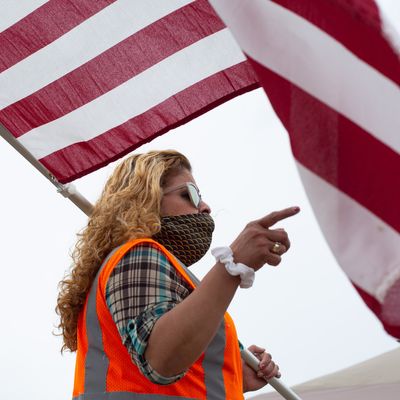
Randy Narvaez had worked for a Denver-area King Sooper store for over 30 years by the time he died from the coronavirus. In a press release, his union, the United Food and Commercial Workers, said there are a dozen cases among his co-workers. Even if they all survive, they’ll see their pay reduced by the time they recover. King Sooper’s parent company, Kroger, ended a $2 “hero pay” bonus this week. Full-time workers will get another “thank you” payment of $400, part-timers get $200, and after that, it’s business as usual. Except it won’t be, not for Randy Narvaez and not for his co-workers, who are pleading with Kroger to extend the hourly bonus or at least shut their store down to clean it.
There’s an old conflict between employers like Kroger and workers like the UFCW’s members; it is far older, in fact, than COVID-19. A great difference in perspective, and thus of opinion, separates bosses from workers at all times. Created by capitalism and wedged open by decades of policy, this gap has fatal qualities, and they have become difficult to ignore.
The pandemic has spawned a thousand ponderous takes about the state of inequality in America. Most concede at minimum that inequality exists and can be dangerous, though some, like a recent New York Times editorial by the libertarian economist Michael Strain, have argued that it isn’t much of a problem. But the pandemic also highlights a curious trend among some in the right wing. These conservatives see value in the notion of inequality. They freely admit that there are haves and have nots, or a front row and back row, and will even speak of exploitation and pain.
But these right-wing populists take one obvious, true point — that lockdown measures inflict economic pain, the severity of which corresponds inversely to a person’s wealth — and journey from there into the land of the goons. Consider a recent effort from Peggy Noonan, a Pulitzer Prize–winning columnist for the Wall Street Journal. Unlike some fellow conservatives, Noonan allows the necessity of mask-wearing and social-distancing. But! “There is a class divide between those who are hard-line on lockdowns and those who are pushing back,” she ventured. A correct statement, though she doesn’t seem to know which side is which. In her version of class war, professional elites stand on one side of the divide, hectoring workers who just want to make rent. “The working-class people who are pushing back have had harder lives than those now determining their fate,” she continued. “They haven’t had familial or economic ease. No one sent them to Yale. They often come from considerable family dysfunction. This has left them tougher or harder, you choose the word.”
But reality doesn’t quite match up with Noonan’s imagination. Workers aren’t pushing back against lockdowns. They’ve organized protests of an entirely different variety. For weeks, they’ve rallied against elites — their bosses — who won’t clean their job sites or hand out enough masks and who take away hazard pay while they’re still dying. This isn’t left-wing sloganeering, but fact. Most Americans overwhelmingly back continued lockdown measures, even if they’ve lost major income during the pandemic. The polling is unambiguous. In April, Gallup reported that low-income adults were still more likely to fear illness from COVID-19 than financial hardship, which by then had already become acute. Later the same month, an IPSOS poll found that high-income households in 14 countries surveyed, including the U.S., were mostly likely on average to support economic reopening. The poorer a household, the less likely a respondent was to agree that states should reopen.
The financial implications of the pandemic have thus been felt most severely among people of color, according to a poll from the Associated Press and NORC — and they are not the people protesting the lockdowns. Though Noonan derided Michigan governor Gretchen Whitmer for calling the protests “racist and misogynistic,” there isn’t actually much doubt that Whitmer was right. Protesters in multiple states waved Confederate flags; some carried anti-Semitic signs. White supremacists flocked to some rallies. At a protest in Whitmer’s state, a man brandished a brunette doll that hung from a noose, which seems plenty “misogynistic,” among other things.
Meanwhile, a more accurate vision of class war emerged in a new Washington Post report on a suburban enclave in Georgia. Allowed to reopen by the state’s Republican governor, Brian Kemp, the luxury Avalon shopping center drew patrons desperate for a venti Starbucks. “I just want to feel normal, I guess,” a woman told the Post. But someone has to pay for normal, and it isn’t necessarily going to be the woman browsing her local Anthropologie. A worker, the Post added, had started her shift “with a prayer,” beseeching a God who was “bigger than corona.” The fear was as unequally distributed as the area’s wealth.
The discrepancy between the Post piece and the Noonan op-ed is partly a product of form. One work is reported; the other is opinion, which is too often a sinecure for the terminally out of touch. A few minutes of research might have salvaged Noonan’s column, but when there’s no expectation that a writer will do anything but pontificate, outlets end up with pieces that manage to be false and dull at the same time.
But Noonan’s errors still have some value. In her haste to cry revolution, she reveals how little the right understands class at all. There is a real socioeconomic divide between Yale-educated epidemiologists and blue-collar workers, but it doesn’t generate lockdown anxiety. And though small business owners are suffering, as Noonan points out, the people who work for them may feel markedly more reluctant to get back on the job. What spilled out into rallies several weeks ago isn’t class war, but culture war. Workers aren’t asking to go back to the mall. They’re fighting to live.






























